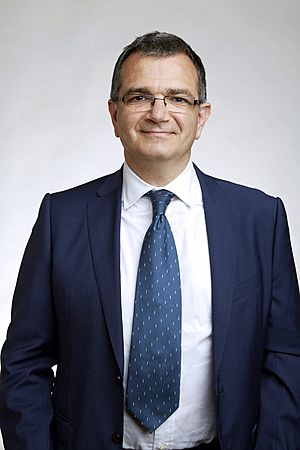Vincenzo Cerundolo facts for kids
Quick facts for kids
Vincenzo Cerundolo
FRS FMedSci
|
|
|---|---|

Vincenzo Cerundolo at the Royal Society admissions day in London, July 2018
|
|
| Born | 20 December 1959 |
| Died | 7 January 2020 (aged 60) |
| Education | Liceo Scientifico De Giorgi |
| Alma mater | University of Padua (MD, PhD) |
| Scientific career | |
| Institutions | University of Oxford John Radcliffe Hospital |
Vincenzo Cerundolo FRS FMedSci (born December 20, 1959 – died January 7, 2020) was a very important scientist. He was the Director of the Medical Research Council (MRC) Human Immunology Unit at the University of Oxford. This unit is located at the John Radcliffe Hospital. He was also a Professor of Immunology at the University of Oxford.
Professor Cerundolo was famous for his discoveries about how our bodies fight diseases. He studied how cancer and viruses are recognized by special cells called T cells. He also researched how certain fats, called lipids, are seen by other immune cells. He passed away from lung cancer in 2020.
Contents
Early Life and Education
Vincenzo Cerundolo was born in Lecce, Italy, on December 20, 1959. His parents were Vittorio Cerundolo and Colomba Vissicchio. He went to school at Liceo Scientifico De Giorgi in Lecce.
After high school, he studied Medicine at the University of Padua from 1979 to 1984. He then continued his studies there. He earned a higher degree in Oncology, which is the study of cancer. His supervisors were Dino Collavo and Paola Zanovello.
Career and Important Discoveries
After finishing his studies, Cerundolo moved to the University of Oxford. He worked with Professor Alain Townsend at the Weatherall Institute of Molecular Medicine. This was his postdoctoral research.
Understanding Immune Responses
Cerundolo made a big discovery about how our immune system works. He was the first to show that special genes, called TAP genes, help transport small pieces of proteins called peptides. These peptides are then shown to MHC class I molecules. These molecules are like flags on our cells that tell the immune system what's inside.
He also found a new health problem in patients whose TAP genes didn't work correctly. This helped doctors understand why some people's immune systems don't fight off diseases well.
Peptides and Immune Cells
Professor Cerundolo also studied how the length of these peptides affects how well they stick to MHC class I molecules. This explained why the peptides found on these molecules are usually all the same length. This research was key to understanding how our immune system recognizes invaders.
Lipids and NKT Cells
He also looked at how fats (lipids) attach to special molecules called CD1 molecules. He showed how these lipid-CD1 complexes are recognized by another type of immune cell, called Natural killer T cells (NKT cells).
His work showed that by using NKT cells, we can make our bodies produce more antibodies and T cells. This helps our immune system fight off specific germs or diseases better.
Leading the Way
In 2010, Vincenzo Cerundolo became the Director of the MRC Human Immunology Unit. This is a very important role in immunology research.
Key Publications
Professor Cerundolo published many important scientific papers during his career. These papers shared his discoveries with other scientists around the world. His work helped advance our understanding of how the immune system fights cancer and infections.
Awards and Honours
Vincenzo Cerundolo received important recognition for his scientific work.
- In 2018, he was chosen as a Fellow of the Royal Society (FRS). This is a very high honor for scientists in the United Kingdom.
Personal Life
Vincenzo Cerundolo got married in 1987. He had one daughter and one son.

